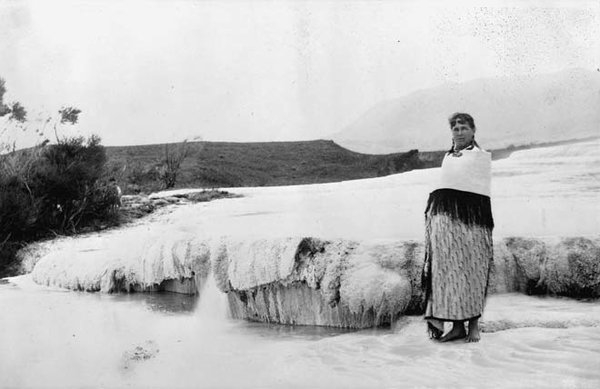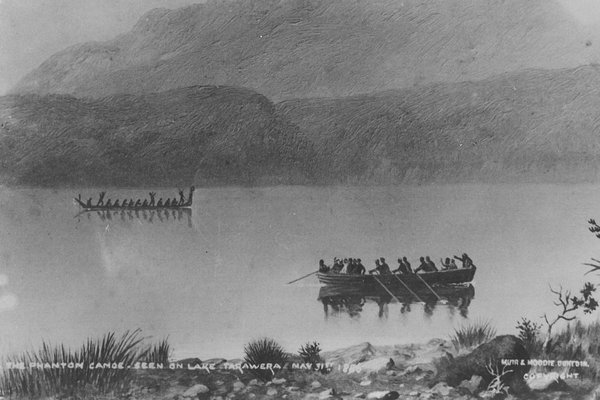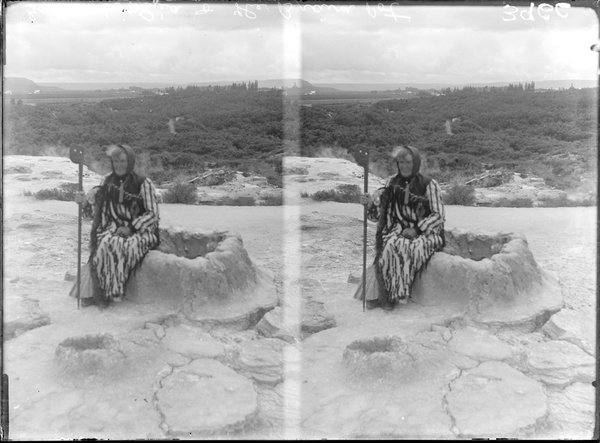The fascinating story of famous Guide Sophia Hinerangi
Te Paea Hinerangi, best known as ‘Guide Sophia’, was the principal tourist guide of the famous Pink and White Terraces at Lake Rotomahana before their destruction in 1886.
Born in Kororarekea (now commonly known as Russell) in the early 1830s, Sophia was the daughter of Kotiro Hinerangi, a Ngati Ruanui woman, and Alexander Gray, a Scottish settler. It is believed that Sophia was raised by Charlotte Kemp at the KeriKeri mission station.
(Photo courtesy of TEARA NZ www.teara.govt.nz)
Sophia married twice but little is known about her first marriage to Koroneho Tehakiroe with whom she had 14 children. She married for the second time in 1870 to Hori Taiwhio. The couple had a further three children and moved to Te Wairoa where Sophia earned a living as a renowned guide. She was said to have had a ‘melodious voice’ that many were fortunate enough to experience on their journey to the Pink and White Terraces.
Intelligent, attractive and bi-lingual, Sophia was not only a guide but a friend and philosopher to many. She was well-educated and her knowledge of the area was invaluable to the tourism industry. For 16 years prior to the destruction of the Terraces, Sophia was the best in the business. She was largely responsible for arranging tours, providing visitors with information and settling accounts.
As a significant role model, Guide Sophia’s independence and skill influenced many other women to follow in her footsteps. It is said that Sophia personified the very best of who Maori were at the time.
Disaster looms and Rotomahana sends warning signs
With a great passion and respect for the natural wonder, Sophia loved to bring tourist parties to the Terraces. However, in 1886, just 11 days before the eruption, Guide Sophia experienced several warning signs that disaster was about to strike.
The day began like any other; Sophia was to lead a tourist party across Lake Tarawera towards the Pink and White Terraces. Before the group had even set foot onto the boat, the lake level suddenly fell only to rise again in seconds. The phenomenon was accompanied by a whimpering sound that eerily echoed across the lake.
Local Maori refused to board the boat but after some persuasion, they agreed to do so. Feeling just as startled, Sophia had a feeling the Lake was sending a warning. As a steam cloud hovered above the lake, Sophia was heard whispering “I don’t think I shall see the Terraces again”.
Shortly after the dramatic change in lake level, Sophia and her tour party were eye witnesses to a phantom canoe. As the canoe approached Sophia and her group, it grew bigger and boasted 13 ghostly occupants, each with a dog’s head. As it shrank into the distance, the canoe disappeared.
To Maori onlookers, it was a waka wairua, a spirit canoe, a sure indication of coming disaster. Although, what form it would take, no one guessed. Shaken by the experience, Guide Sophia felt these events were signs that her time at Lake Rotomahana was coming to an end.
Mt Tarawera erupts, Sophia offers shelter
On June 10 1886, Mt Tarawera painted the sky with fire and covered Te Wairoa in thick ash and mud. Violent electrical storms, hurricane force winds and powerful earthquakes sent panic among the village.
As people desperately sought shelter from the falling debris, Sophia opened her home. Unlike many of the village’s buildings, Sophia’s home withstood the force of the eruption due to its steep-pitched roof and strong timber walls. Over 60 people survived in Sophia’s sturdy whare that fateful night.
The ominous warning signs confirmed Guide Sophia’s unsettled feelings. The Terraces were obliterated and Te Wairoa was no more. Her flourishing career on Lake Rotomahana had come to an abrupt end and she left the devastated Te Wairoa village to set up a new life in Whakarewarewa.
Much later, Guide Sophia remembered the old chief, Rangiheuea, had offered her tapu honey that he had collected on Mt Tarawera. Knowing it was tapu, she instantly refused but many others ate it. In a bizarre twist of fate,everyone who ate the honey died in the eruption, including the chief.
An influential and respected woman
After moving to nearby Whakarewarewa, Guide Sophia continued with her guiding career.
Having experienced the country’s largest natural disaster, Sophia had an incredible story to tell. In 1895 she joined George Leitch's Land of the Moa Dramatic Company where she toured Australia performing as herself in a play based on the eruption.
Her wealth of knowledge and natural way with tourists saw Sophia appointed as Caretaker of the Whakarewarewa Thermal Reserve in 1896. Among the many tour groups, Sophia led a number of royal parties through the Reserve. At the time, Guide Sophia was one of the most well-known women in Rotorua.
(Photo courtesy of Auckland City Libraries www.aucklandcity.govt.nz)
As a public figure and role model, Sophia put her status to good use and encouraged a number of local women to become guides. She had established tour guiding as a lucrative occupation and helped many local Tuhourangi women into the industry. Sophia gave these women the gift of independence through earning their own living.
Guide Sophia died at Whakarewarewa on 4 December 1911. She had a large family and many descendants still live at Whakarewarewa.
Her name lives on today in Rotorua’s Sophia Street.











Connect with Us
Facebook YouTube Instagram Tripadvisor Blog Email